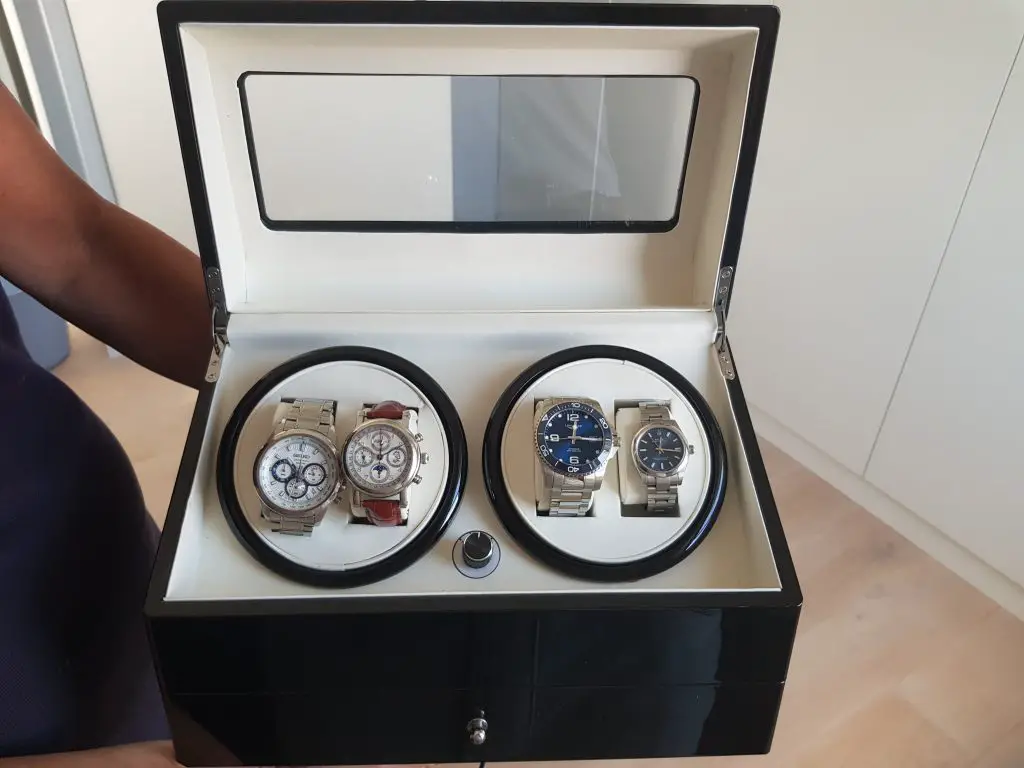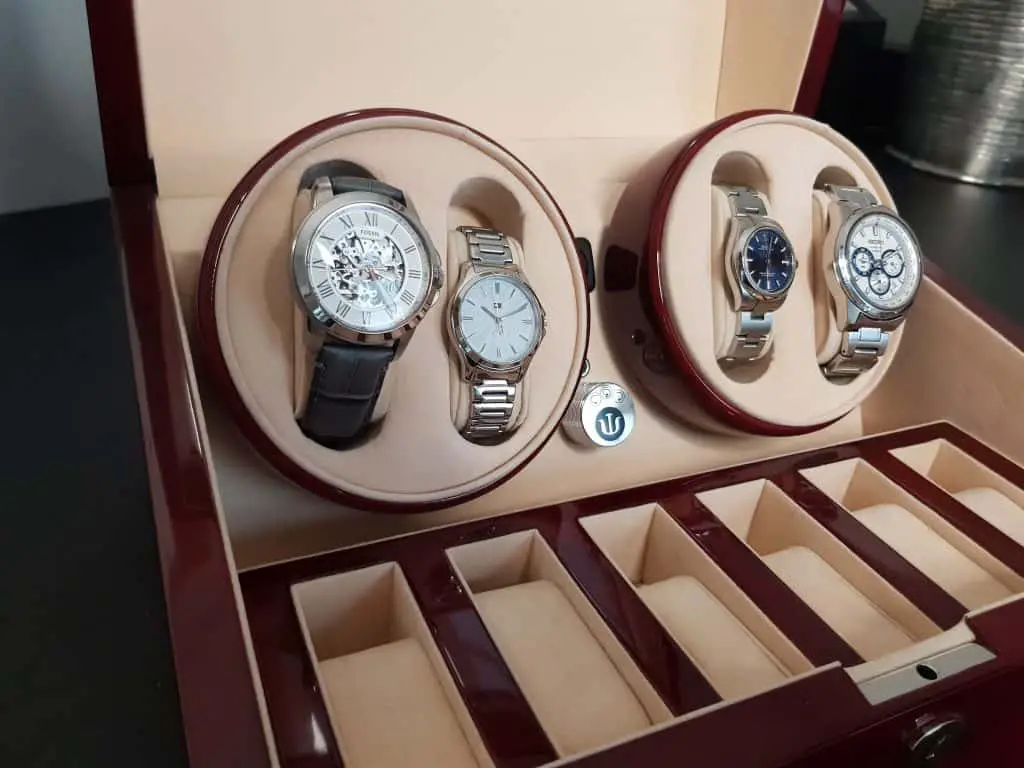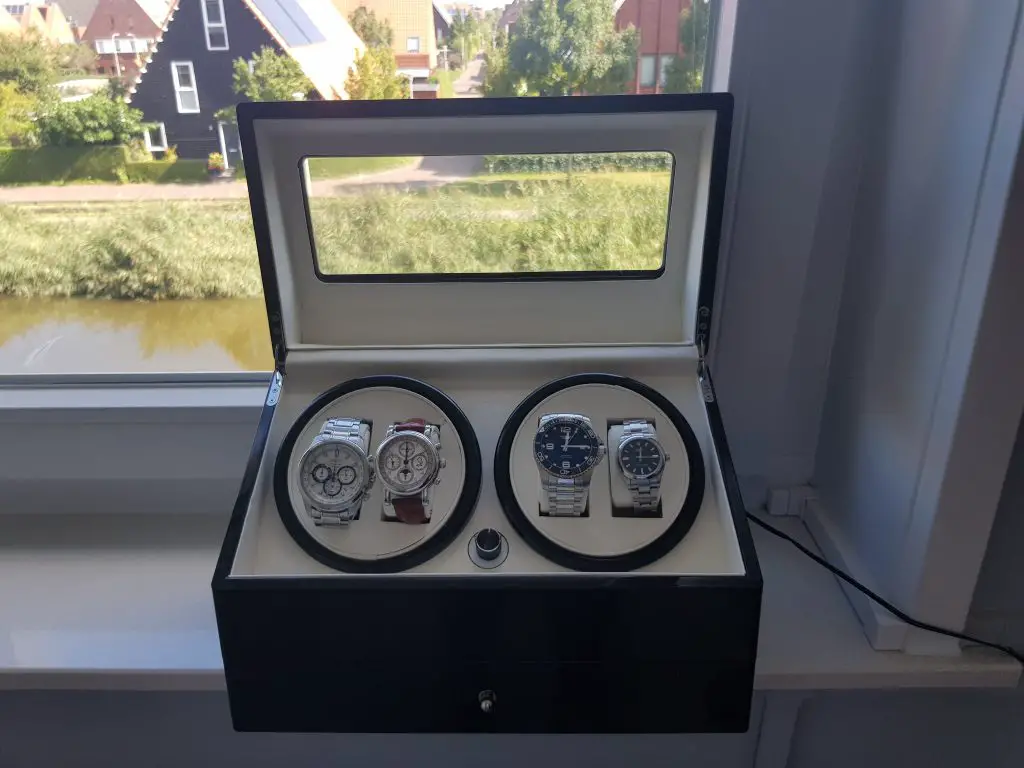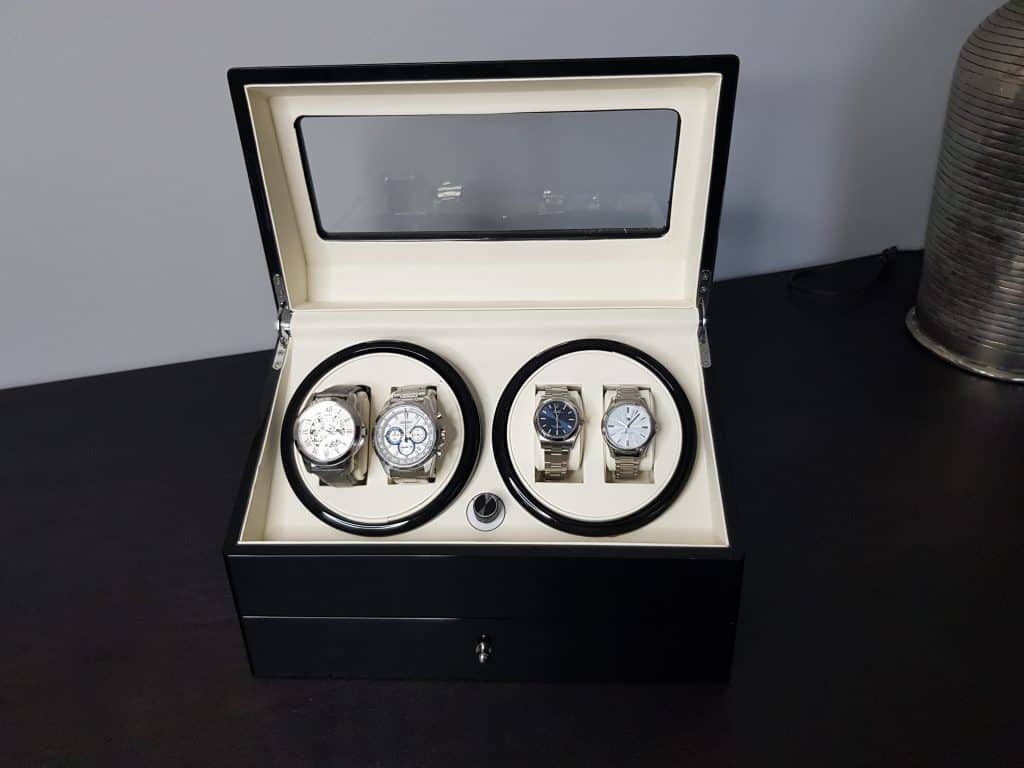Most people that own a few watches will at one time consider purchasing a watch winder. You can’t wear all your watches at the same time, after all. But can a watch winder damage your watch?
A good quality watch winder will not damage your watch, but some of the budget options could be harmful. Poor quality watch winders could cause magnetization or signs of wear on the slip clutch, which makes sure the watch won’t be overwound.
The last thing you want is your watch winder damaging your precious timepieces. Luckily, not all watch winders are damaging, and in general, a watch winder is great to have. In this article, we’ll dive deeper into everything there is to know about watch winders, how damaging they are, and if you should even use them.

Table of Contents
How Can A Watch Winder Damage Your Watch
Watch winders are extremely popular, but apparently, they can be damaging to your watch. But how does a watch winder damage your watch?
A watch winder can damage your watch by either overwinding it or by magnetization. Both overwinding and magnetization can be damaging to the mainspring and slip-clutch, damaging the inside mechanism of the watch.
Watch winders are generally very helpful for automatic watches. These automatic watches keep themselves wound by the movement of the wearer. When you stop wearing the watch, you’ll stop winding the watch, which eventually makes it stop working.
This is usually after 72 hours, give or take, after which, the watch will stop working. Here is where a watch winder comes in. The watch winder will keep the watch moving so that even when you don’t wear it, the watch will still be wound.
Inside the watch winder, you’ll see that your watch will rotate slowly. This keeps the mainspring of the watch wound. What it won’t do, however, is wind up the watch. The movements of the winder will simply keep it at its current level.
But a watch winder can actually damage your watch in some rare cases. Some argue that a watch winder can damage the watch with the unusual movements and angles it gets in inside a watch winder. But that’s quickly disregarded, as a watch winder mimics the movement of your wrist. Your wrist moves around and isn’t always upright.
Some more pressing matters are magnetization and overwinding. But how exactly do they damage your watch? Let’s find out!
Overwinding
Overwinding your watch is an insanely rare occurrence. Watches have something called a slip-clutch in place that prevents the watch from overwinding. In turn, this prevents the mainspring from being damaged.
So actually overwinding your watch is not something that would happen often, if ever. But the problem lies in the fact that constant pressure on the slip-clutch could end up damaging it.
Excessive pressure on the slip-clutch could end up wearing it out, and once the slip-clutch is damaged, the mechanism inside the watch could be damaged as well.
Usually, with a good quality watch winder, this won’t really happen. If your watch winder is of good quality and compatible with the brand of your watch, you won’t really encounter these problems. Especially if you have your winder set at the correct Turns Per Day (TPD).
Finding the correct turns per day for your watch can be quite tricky. You can either calculate this or just look them up. On this website, you can choose pretty much any brand, as well as all of the models of that brand. They’ve listed the appropriate turns per day, as well as the winding direction, so you don’t have to figure all of that out yourself.
A Rolex Daytona, for example, can be wound in both directions, with 650-800 turns per day. On average, most watches can be wound in both directions with 650 turns per day. Sometimes, however, you can find some outliers, like the Rolex Daytona, which can have up to 800 turns per day.
Magnetization
Magnetization is a more common issue when it comes to watch winders damaging a watch. Magnetization is when the electric motor and magnet in the watch winder start to create a small magnetic field.
This magnetic field can mess with the mainspring inside the watch, causing it to be sticky and less accurate. The sticky mainspring also erratic movements instead of the smooth glide or tick you’d come to expect.
Of course, this is something you want to avoid. Luckily, most quality watch winders come with a ‘shield’ that absorbs the magnetization. This shield is usually a piece of steel, which prevents the magnetic field to influence the insides of the watch.
Again, even though magnetization is more common than overwinding, it’s still fairly rare and easily remedied by purchasing a quality watch winder.

Will Every Watch Winder Damage Your Watch
As mentioned before, not every watch winder will damage your watch. The most common forms of damage, magnetization and overwinding, are very rare to begin with. And with a quality watch winder, these problems are pretty much negligible.
Not every watch winder will damage your watch. A good quality watch winder will have precautions build in to avoid damaging the watch. Even lower quality watch winders will rarely cause damage.
As long as you’re using a quality watch winder, you shouldn’t really have to worry about any damage done to your timepiece. The most common way you’ll damage a watch with a watch winder is by magnetization or overwinding, and both of these issues can be resolved and prevented by purchasing a quality winder.
A quality watch winder will have some sort of shield that will absorb any magnetic waves that could otherwise reach the inside of the watch. This prevents magnetization, taking away one of the more common ways to cause damage.
Aside from preventing magnetization, a quality watch winder will also have some settings where you can determine the turns per day. This way, you won’t overload the slip-clutch, as the watch winder won’t wind your watch to the point of overwinding.
Quality is really important here. Especially because most watches that could benefit from a watch winder are luxury watches. These are on the more expensive side, so accidentally damaging them is the last thing you want to do.
How To Make Sure Your Watch Winder Is Not Damaging Your Watch
Ensuring your watch won’t get damaged inside a watch winder isn’t too difficult. Aside from purchasing a quality watch winder, you really only need to know what settings are best for your watch.
Often times, a watchmaker will aid you with this. But that isn’t always the case, or you might have forgotten his or her advice. Just know that you can always contact your watchmaker and check what your best options are. They’ll gladly help you.
If for some reason, you can’t contact your watchmaker, you should do your own research. The process of overwinding is really stressful on the slip-clutch, so this is something you want to avoid at all costs.
Luckily, figuring out the maximum turns per day is pretty easy. For most watches, 650 turns per day is fine. This is pretty much the standard for around 80-90% off all watches.
However, there are a few exceptions. The earlier mentioned Rolex Daytona can go up to 850 turns per day, but this isn’t the only outlier. You can always check out the ideal turns per day for your watch on this handy site!
Now, when you buy a quality watch winder, chances are there’s something in place that ensures the magnetic field created by the electric motor and magnet to not have an influence on the insides of the watch. This comes down to the quality of your product.

Should You Use A Watch Winder
Now that you know that a watch winder could damage your watch, you might wonder, should you even use a watch winder?
A watch winder is a great addition to any watch collector. A watch winder keeps the watches moving and wound, ensuring they’re up to date and displaying the correct time.
The main feature of a watch winder is to keep the watch wound. It does this by slowly spinning around, mimicking the movement of your wrist. This keeps the mainspring leveled, so the next time you wear your watch again, it’s as if you’ve never taken it off.
Watch winders are really only useful for watches that need to be wound manually by movement. A quartz watch, for example, is powered by a small battery, which will keep on powering the watch until the battery dies out.
In the case of an automatic watch, you’ll power the inside mechanism and mainspring by moving around. Movement powers the watch and when you take your watch off, you can keep the movement alive by placing it in a watch winder.
If you just leave your watch on the table, you’ll see that after around 72 hours or so, the watch will stop moving. When this happens, you’ll have to manually set the correct time again.
Another drawback to leaving your watch laying dormant is that the lubricant inside the watch can start to slowly dry up. The lubrication is necessary for the smooth movement of a watch, and when this dries up, you can experience more sporadic and shocking movement.
Even though there are a few minor downsides to using a watch winder, in the end, it’s ultimately a great investment, provided you purchase one that’s of high quality.
Especially if you have a watch with a perpetual calendar. These are watches with complicated complications that ensure the correct date is shown at all times (read this article to find out how watches keep the date!). These calendars show the correct dates for every month and even take leap years into account. Keeping these running is definitely to your benefit.
And besides being functional, a watch winder, filled with the most beautiful timepieces is the perfect addition to any home. It looks luxurious and classy, but also has a function.
How Long Should You Leave Your Watch On A Watch Winder
How long you should leave your watch on a watch winder completely depends on your watch and the settings of the winder. Generally, though, you can leave your watch on a watch winder for a very long time.
You should leave your watch on a watch winder for a limited time per day. Constantly having your watch be wound could cause wear and tear, so you don’t want your timepiece to be on there for too long.
Every movement will cause the watch to do its work. If your watch is moved at all times of the day, signs of wear and tear could start to show up. It’s the same for any product, really. The more you use it, the faster it shows signs of wear.
That’s why most watch winders have several different settings. These settings dictate how long the watch will be wound and how long the pauses in between will be. These pauses are essential to keeping the winding components inside the watch in-tact.
Most watches need an average of 650 turns per day. To achieve this, you really don’t need to have your watch be spun around for the whole day. Any intermediate setting that has its turn every now and then, with a few pauses in-between will be great.
You should also not forget that when you’re wearing the watch, your own movements also winds it up. So if you’re wearing your watch every day or every other day, there really is no need for your watch to be wound for too long at a time.
Your own movement will ensure it’s wound up all the way, and the watch winder will make sure it stays at that level. And when you take it out of the watch winder, there’s still close to 72 hours left before your watch starts to stop working.

How To Set Your Watch Winder To The Correct Settings
Always take a look at the instructions and manuals provided with the watch winder. However, if you can’t find the settings or lost the instructions, you can always experiment a little bit. To do this, make sure your watch is wound and keeping correct track of time.
Once this is done, place your watch in the watch winder and have it on the lowest setting. Turn on your winder and leave it be for around 2 days. After the 2 days, go check if your watch is still keeping correct track of the time. If not, crank your settings to the next speed level.
Then repeat the same process until you find the setting that makes your watch keep the time perfectly. By starting this process on the lowest setting, you minimize the risk of anything breaking because it’s going too fast. And because you gradually work your way up, you’ll find the perfect setting before it becomes too much.
If your watch is still showing the wrong time, even at the highest speed setting, try dabbling with the watch going clockwise or counterclockwise. Do the opposite of what you’ve been doing and restart the experiment. This way, you’ll find the correct setting, even if the watch needs to go counter-clockwise instead of clockwise!
Now, this is a rather long process, but once you’ve got it figured out, you won’t have to do it again. Just make sure you note the correct settings somewhere in case you forget it again.
If, for some reason, your watch starts incorrectly showing the time again, make sure to double-check your winders settings. If these are all correct, chances are your watch might need some servicing. Contact your watchmaker and see what the options are. But generally, this won’t really happen.
Closing Words
If you own multiple automatic watches, purchasing a watch winder is probably a great investment. You can’t wear multiple watches at the same time, and the watch winder will ensure that your watches are kept up to date.
Automatic watches are wound by movement. This can be the movement of your wrist when you’re wearing your timepiece, but it can also be the movement of a watch winder. The watch winder basically mimics the movements of your wrist, ensuring the watch is wound even when it’s not worn.
Now, this is especially handy for the more expensive luxury watches, especially those with perpetual calendars. A perpetual calendar is a nifty complication that perfectly keeps the date on your watch, even through gap years. These watches have very delicate inside mechanisms, so you want to avoid having to manually wind them as much as possible.
That’s where watch winders come in. But some people say that watch winders can actually damage your watch.
While this is partially true, a high-quality watch winder, made by a reputable company, won’t be damaging to a watch.
The damage a watch winder can cause is overwinding, which can be helped by using the correct settings, and magnetization, which will be helped by placing a steel ‘shield’ inside the watch winder’s mechanism.
If you buy a quality watch winder, there really isn’t much to worry about, provided you are using it correctly!
